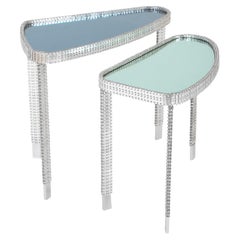Philippe Montels
Recent Sales
21st Century and Contemporary French Modern Nesting Tables and Stacking ...
Cut Glass
A Close Look at Modern Furniture
The late 19th and early 20th centuries saw sweeping social change and major scientific advances — both of which contributed to a new aesthetic: modernism. Rejecting the rigidity of Victorian artistic conventions, modernists sought a new means of expression. References to the natural world and ornate classical embellishments gave way to the sleek simplicity of the Machine Age. Architect Philip Johnson characterized the hallmarks of modernism as “machine-like simplicity, smoothness or surface [and] avoidance of ornament.”
Early practitioners of modernist design include the De Stijl (“The Style”) group, founded in the Netherlands in 1917, and the Bauhaus School, founded two years later in Germany.
Followers of both groups produced sleek, spare designs — many of which became icons of daily life in the 20th century. The modernists rejected both natural and historical references and relied primarily on industrial materials such as metal, glass, plywood, and, later, plastics. While Bauhaus principals Marcel Breuer and Ludwig Mies van der Rohe created furniture from mass-produced, chrome-plated steel, American visionaries like Charles and Ray Eames worked in materials as novel as molded plywood and fiberglass. Today, Breuer’s Wassily chair, Mies van der Rohe’s Barcelona chair — crafted with his romantic partner, designer Lilly Reich — and the Eames lounge chair are emblems of progressive design and vintage originals are prized cornerstones of collections.
It’s difficult to overstate the influence that modernism continues to wield over designers and architects — and equally difficult to overstate how revolutionary it was when it first appeared a century ago. But because modernist furniture designs are so simple, they can blend in seamlessly with just about any type of décor. Don’t overlook them.
Finding the Right Nesting-tables-stacking-tables for You
Antique and vintage nesting tables and stacking tables first became popular in the early 1800s. With individual tables being used for afternoon tea, needlework and other activities, nesting tables were a perfect solution to clear up clutter at the end of the day.
These tables remained a staple of interiors over the decades for their versatility. In the 1920s, German-born American artist Josef Albers designed a modern version with each table a different color. At the Bauhaus, the German art and design school and chief crucible of modernism founded by architect Walter Gropius, Albers wasn’t the only designer to reinterpret the nesting table. Hungarian-born architect Marcel Breuer also introduced a model with chrome-plated tubular steel legs and lacquered plywood surfaces.
One can now find a range of gorgeous, carefully crafted designs, such as a three-level set of solid oak nesting tables, naturally oiled and finished with Calacatta marble. A game-themed set of nesting tables is a must-have for a living room or lounge, while a small office can be accented with vintage Scandinavian nesting tables made of teakwood, a sought-after material among mid-century modern designers.
Browse the unique collection of antique and vintage stacking tables and nesting tables on 1stDibs to find hundreds of options to match your office or living space.
Read More
Why Drew McGukin’s Colorful Home Differs from Those of His Clients
The New York–based designer has a high-impact style that's all his own, as his loft in the Chelsea Flower District makes abundantly clear.
New Orleans’ Lee Ledbetter Makes Design Magic by Mixing Past and Present
The Louisiana-born and -bred architect talks to 1stdibs about the art of making timeless places that matter.
How a Modernist Hamptons Home on the Water Became the Ideal Weekend Refuge
Damon Liss and Stelle Lomont Rouhani Architects collaborated on this serene getaway for a minimalism-minded Manhattan family of four.
Desert Modern Designer Arthur Elrod Finally Gets His Day in the Sun
The Palm Springs interior decorator developed a mid-century style that defined the vacation homes of celebrities and other notables, including Bob Hope and Lucille Ball.
Artelinea, Mexico City’s One-Stop Contemporary Design Shop, Paves the Way for a New Wave of Mexican Designers
Wielding her influence on the international scene, founding partner Andrea Cesarman expands the platform for Mexican artisans.
From the Hamptons to Palm Springs, FormArch’s Homes Embody Both Comfort and Cool
The houses from this New York studio cloak modernist tendencies within what are often more traditional trappings.
Wendy Haworth’s Luminous Spaces Epitomize L.A. Ease
For the California designer, authenticity and the unusual are the keys to cool, timeless interiors.
